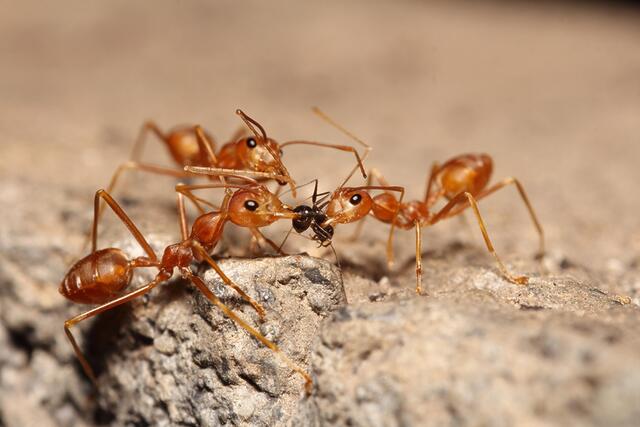
Red Imported Fire Ant headquarters visit
On 26 February, the Australian Chief Environment Biosecurity Officer, Dr Bertie Hennecke and staff from the Environmental Biosecurity Office travelled to Berrinba in Queensland for the first project board meeting of the National Fire Ant Eradication Program.
The visit provided the perfect opportunity for Dr Hennecke to see first-hand the control methods being used to contain and eradicate Red imported fire ants (RIFA) from Australia.
At RIFA HQ, the central hub for the program, the extent and sophistication of the program became clear with pallets of bait ready for field use, vehicles with specialised equipment, and an on-site laboratory.
The program relies heavily on scientific and technical research, advice and expertise provided by program scientists and external Australian-based and international research partners. The laboratory supports the program scientists who continually review and research current and emerging scientific techniques and processes relevant to fire ant detection, diagnosis, and treatment to ensure best practice in fire ant eradication. Live fire ant colonies are also maintained on-site to support imprinting of odour detection dogs.
During his visit Dr Hennecke was given a demonstration of an odour detector dog in action sniffing out a nest. The detector dogs are used to examine high-risk areas where large amounts of soil, mulch and quarry products may be moved from one location to another providing a lift to any ants hidden in the materials.
“Seeing a fire ant nest up-close reinforced for me, just how critical it is that we continue our efforts to eradicate RIFA. What makes this particular ant species so dangerous is its ability to swarm and sting repeatedly when the nest is disturbed,” Dr Hennecke said.
Dr Hennecke also participated in a site visit to watch a field team chemically eradicate a RIFA nest by direct injection of pesticides approved by the Australian Pesticides Veterinary Medicines Authority.
“Detecting and treating nests over such a large area is costly, but the Australian Government is committed to eradicating fire ants and has invested $296 million over the next 4 years which is a of the national program’s budget,” Dr Hennecke said.
“We recognise it is a challenge to eradicate RIFA, but delivering the response plan is the best tool we have to combat these fire ants in South-East Queensland and eradicate them by 2032.
“It is vital that Australians understand the importance of this pest and that we all play our part in the response,” said Dr Hennecke.
If you see an unusual ant in your garden, when you’re out walking or playing sport, report it immediately by visiting the National Fire Ant Eradication Program website fireants.org.au or phoning 13 25 23.
For further information about Red imported fire ants and the national response, visit fireants.org.au


